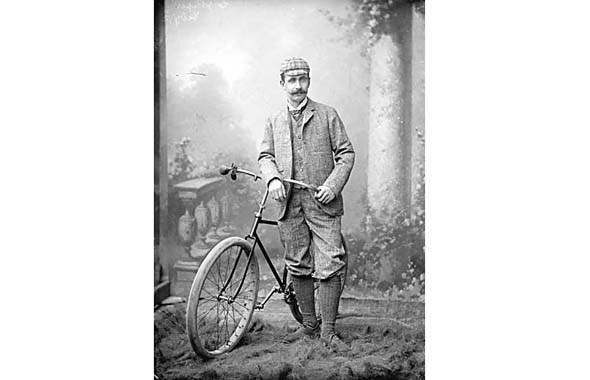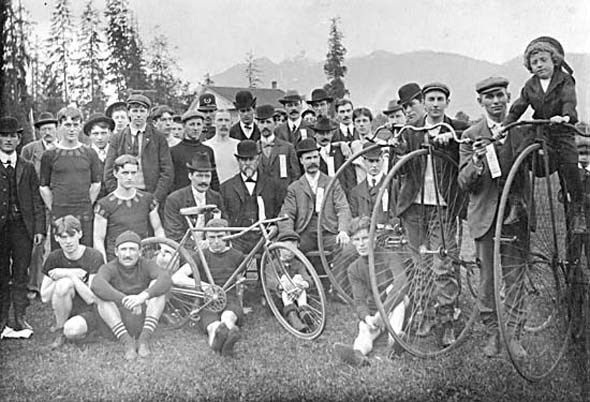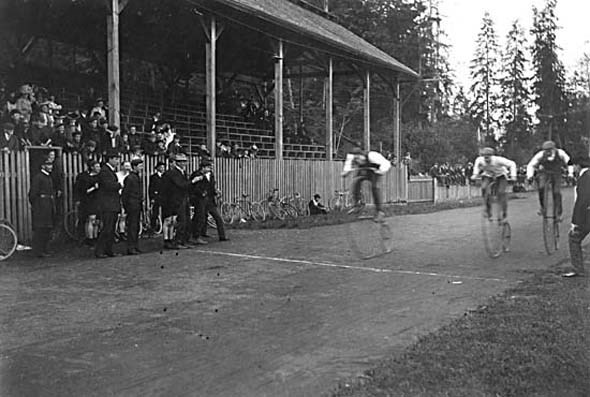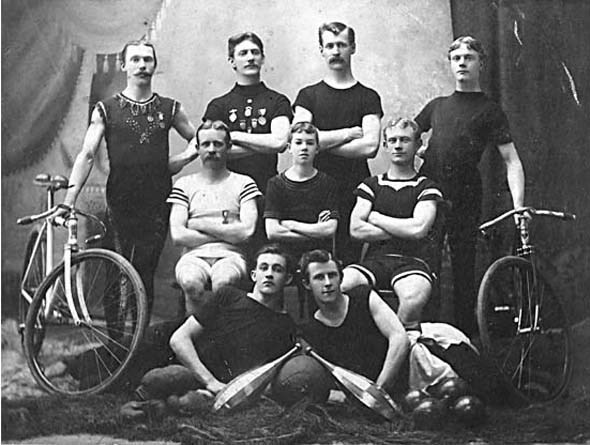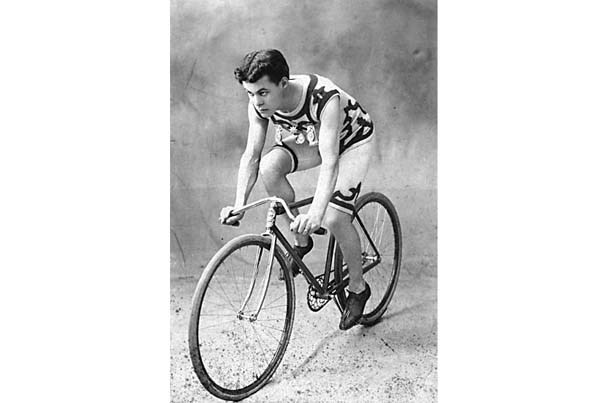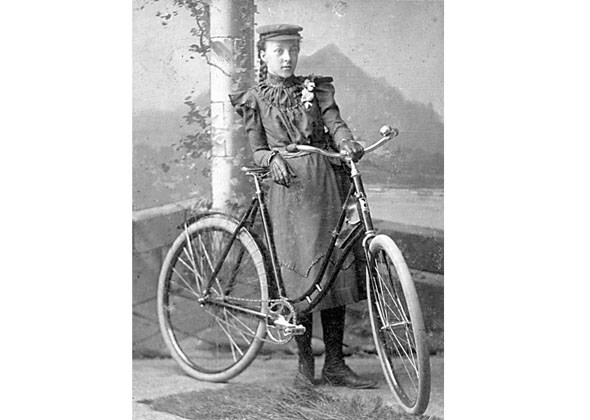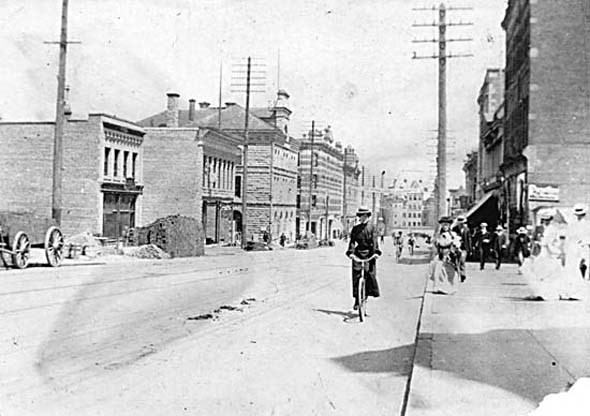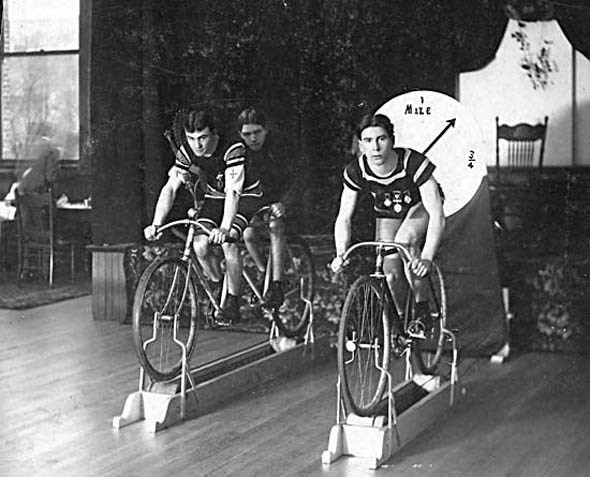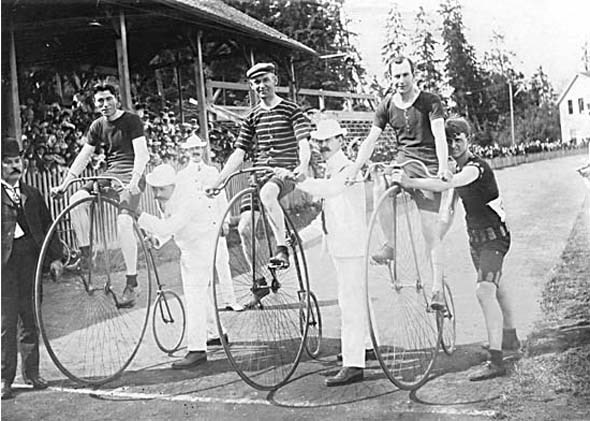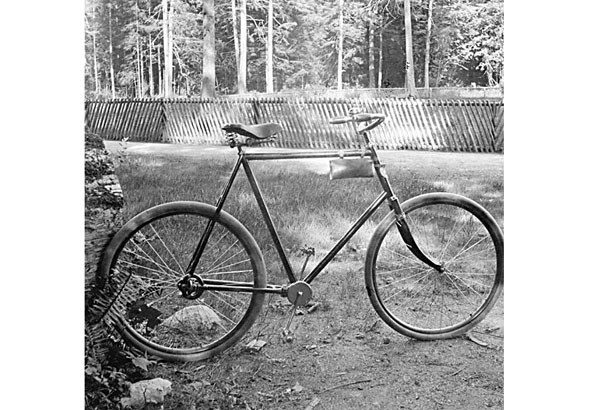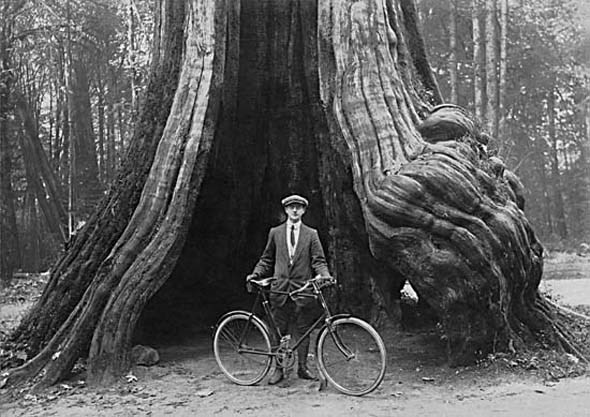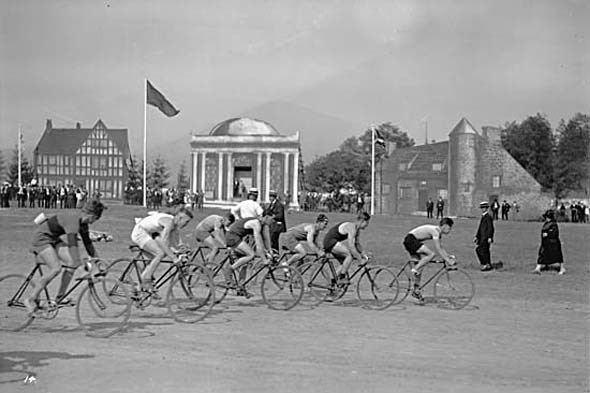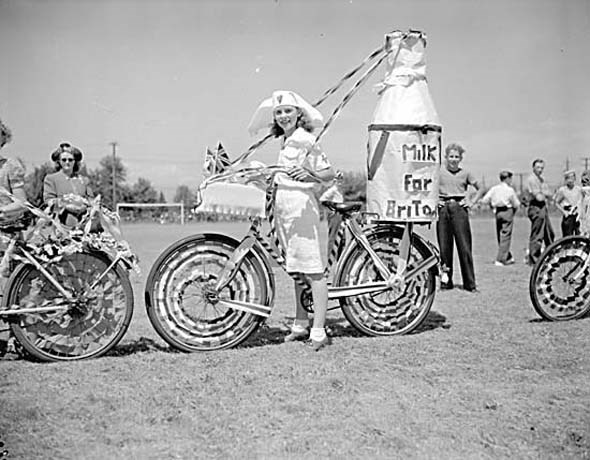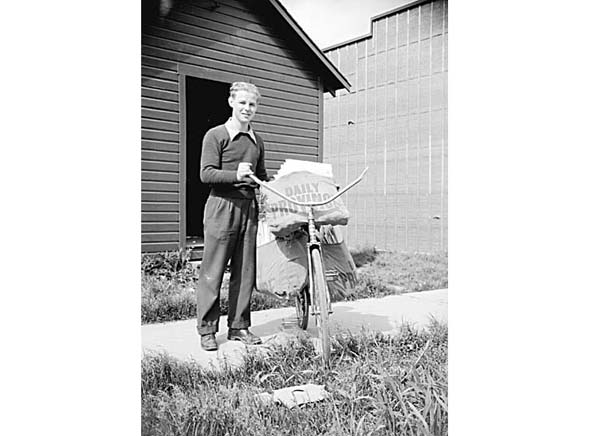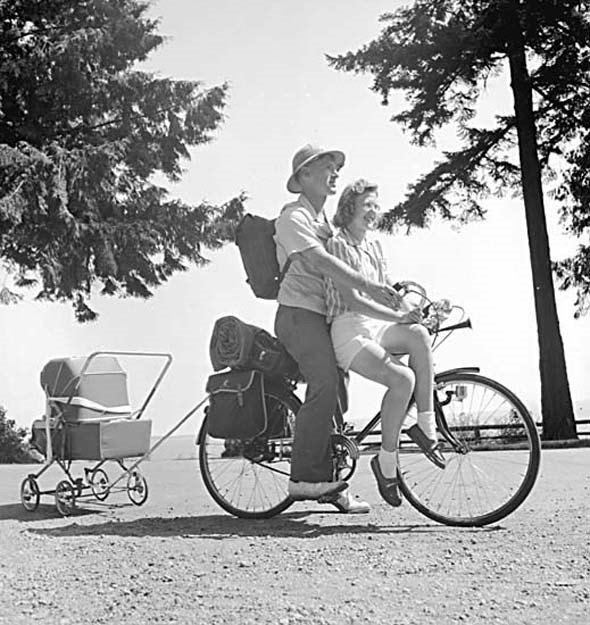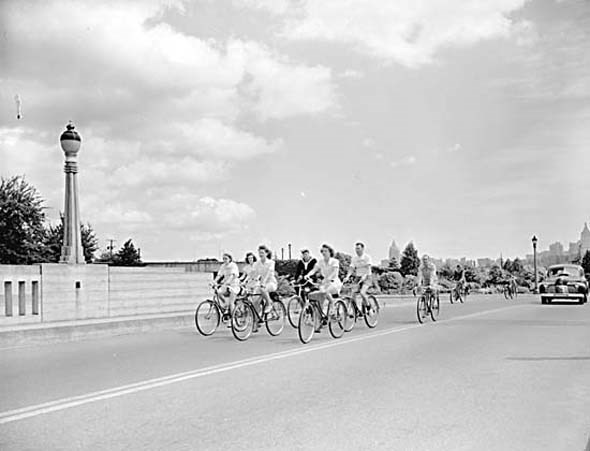Part of the fun of having historical resources digitized is doing random keyword searches for topics of interest.
Since June is bike month, and I keep getting reminders about all the community bike rides going on for the next few weeks, I thought I'd search "bicycle" in Major James Skitt Matthews' Early Vancouver.
One thing I read was an amusing and yet friendly exchange from 1936 between Chas Piper and Robert Mathison, over which of them was "the first cyclist in Vancouver."
And then I found — and what a find! — a big entry written by Matthews in 1931 on the bicycle 'craze' hitting Vancouver in the early 1900s.
Matthews documented some of the technological and infrastructure changes, policing issues, and the business climate around the bicycle revolution; and he also noted some of the fashion and recreation alterations that cycling brought to this so-called 'no fun city!'
Enjoy that excerpt re-posted below and, at the end of this post, you'll find a bunch of photos from of the early decades of cycling in Vancouver from the Vancouver Archives' general digital holdings.
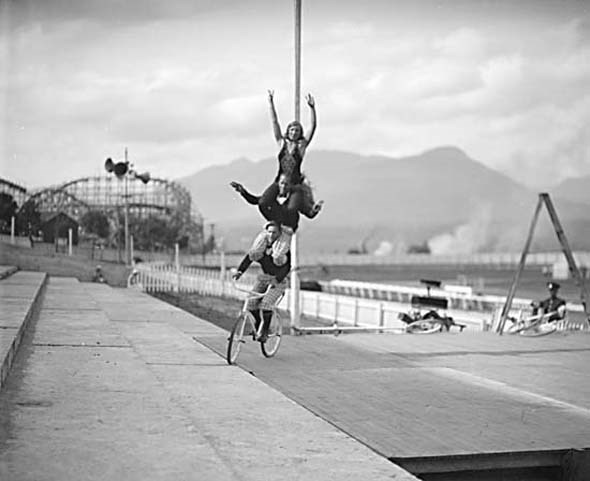 1932 - Bicycle acrobats perform at the PNE at Hastings Park. (Vancouver Archives Ref: CVA 99-2735)
1932 - Bicycle acrobats perform at the PNE at Hastings Park. (Vancouver Archives Ref: CVA 99-2735)
(From Early Vancouver, Volume 1, pages 79-81)15 JULY 1931 - BICYCLES AND BICYCLE PATHS.
The bicycle “craze” was prevalent in Vancouver, as elsewhere, about 1900; almost every family had at least one, some had more; nearly all young men, and most young women, many elderly men and some elderly women rode. It was a convenient mode of travel in a city as yet unprovided with a full street car service; a growing city badly scattered, and among a people who, as yet, had acquired no individual wealth to speak of. Motor cars were still some years off, many had neither facilities, room, nor means to possess stables or buggies. The bicycle was no longer the unwieldy “penny-ha’penny,” big wheel small wheel affair. The “safety” bicycle had come, and with it the Dunlop pneumatic tire; and the “coaster brake” was soon coming. Both wheels were the same size now; it was easily mounted and dismounted, and a fall from it rarely gave much hurt, as the old high wheel, hard tire “wheel” did.
The bicycle became so popular that racks were put up in the vestibules of the small office buildings to receive the “machines” of those employed there and who had business there. At the City Hall, there was a long rack which would accommodate perhaps two dozen bicycles. Similar racks existed at the C.P.R. Depot, and also public places such as parks, post office and hotel lobbies. At the corner of Pender and Granville streets, where now stands the Rogers Buildings, a school for bicycle riding was flourishing. It covered two or three lots, about 75 feet by 120 feet, covered with crushed cinders pressed down, and fenced with a high fence to hide it from the curious, for pupils did not take kindly to making a public amusement for street spectators by their efforts to stay on a “wheel.” Dealers in bicycles did a “land office” business, the managers of wholesale bicycle firms were important men and well known. Repairs shops were many; a knowledge of the merits or demerits of the different makes was essential to any young person with pretences of being up-to-date, and the performance of the best and fastest riders at the big bicycle meetings at Brockton Point and elsewhere were discussed on the corner, in the drawing room and the newspapers. Manufacturers advertised widely; one form was to have trick riders—men who rode on one wheel, etc.—perform on the street in the daytime, usually evening, for the enlightenment of passersby. All kinds of gadgets were invented as accessories, including “fancy toned” bells (rung with the thumb to warn pedestrians to get out of the way), lamps of fancy design (which burned kerosene), extra hand brakes, handles and handlebars of high, low and medium twist, mud guards large and small, rims of wood and rims of polished metal; and they all had their advocates, some violent. A pair of bicycle clips was an article of common household furniture, as necessary as a street car ticket is now.
At the period spoken of, concrete sidewalks were limited to the space in front of some of the more recently constructed downtown buildings; all others, on Granville, Hastings, Cordova streets were wooden planks running crosswise; in the residential streets all sidewalks were of wood, mostly five-foot width crosswise save in the more sparsely settled, newer districts, where they were three-plank lengthwise. The streets were largely macadam or wooden plank. In winter, the macadam was muddy; the planks, frequently loose, had a nasty habit of squirting dirty water up the cracks between when a weight passed over, frequently soiling the trouser legs. This led to riding on the wooden sidewalks, especially in the dark or dusk. Pedestrians on these walks noised their objections with the result that a by-law regulating bicycle traffic and bicyclists was passed by the City Council. The fine for the first offence of riding on a sidewalk was five dollars; it was unlawful to ride a bicycle at night without a light. A license to ride was necessary, and the police were kept busy enforcing the law; a daily crop of charges were heard at the police court.
The “machines” were so numerous that the City Council ordered special bicycle paths constructed on those streets which were most frequently used. These paths were invariably cinder surfaced, and rolled flat, and ran along the edge of the street between the gutter and wooden sidewalk. They were about six feet wide, and constantly kept in order, level and smooth, by city workmen.
The bicycle paths led to and from some well-frequented area, or beside streets where there was considerable vehicular traffic. One ran from Seymour Street, along the north side, to the entrance of Stanley Park; another on the west side of Seymour from Robson to Pacific Street; a third from Granville Street South (from the Third Avenue Bridge) from the bridge, along the north side of Third Avenue to about Maple Street, where the track turned off in an indeterminate direction through the clearing until it reached Greer’s Beach. This cinder path ended at Maple Street. There must have been others; I think there were, perhaps on Pender Street West, to the Park, on Powell Street, on Westminster Avenue leading to Mount Pleasant, and on Beatty or Cambie streets to the bridge, and then up the hill on the south side of False Creek. These cinder paths ceased as they approached the centre of the business section of that day.
Gradually, the bicycle craze died down, and the street car system was extended into even remote and sparsely settled districts; then the motor car came. The bicycle paths fell into disrepair, and finally mysteriously disappeared.
J. S. Matthews
NOTE ADDED LATER:
This was written in 1931. It’s very different in 1941. Many bicycles now. JSM
Do you have a favourite line from 'the bicycle craze' excerpt?
Do you know something else fun or notable about Vancouver cycling history?
Have you found some awesome old cycling photos somewhere?
Then scroll down and leave a comment!

